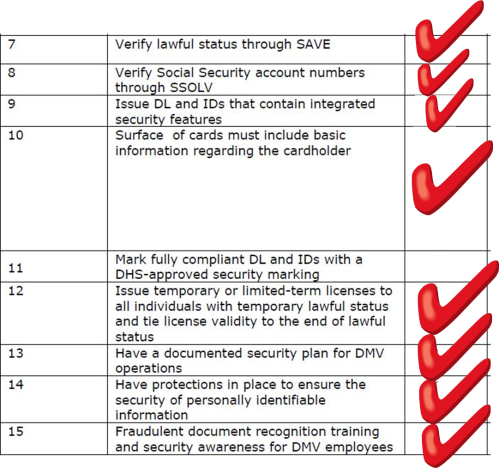
Let me cut to the chase here.
Homeland Security Presidential Directive 24, signed in 2008 and revalidated in 2009 by the current administration, mandates that interoperability with respect to biometrics spans the military, civil, and criminal arenas.
http://www.biometrics.dod.mil/Newsletter/issues/2009/Sep/V5issue3.html
Using at-a-distance- biometrics like facial recognition and retinal scans will certainly put a damper on dissent…..
Its not just Texas. There seems to be a mad dash across the US to begin to put the cameras and databases to work.
The story you read below is also one I see repeated everywhere. We say NO! Our elected Representatives say NO! But the bureaucrats keep pushing until they get what they want.
You want to know where your sovereignty and liberty is going? It is slipping right though the hands of a bunch of unelected, uncountable bureaucrats.
We are not being represented-we are being Wahooed!
Here are a few interesting stories out of the great state of Texas that might give us pause for thought.
Houston Chronicle
Homeland Security picking up tab for 250-300 surveillance cameras
Nov. 24, 2010,
The city is installing 250 to 300 cameras at downtown intersections in an effort to prevent and fight terrorism and crime, part of a security initiative sponsored by the U.S. Department of Homeland Security.
The cameras, which the city began installing in earnest this summer, already have helped police catch car burglars in the act, said Dennis Storemski, the city’s director of the Office of Public Safety and Homeland Security. Eventually, he said, the cameras could be used to allow dispatchers or officers approaching a crime scene to survey what’s happening from their patrol vehicles before they arrive.
Read More
2010 State Fair of Texas using Facial Recognition
https://crossmatch.com/State-Fair-Texas-using-Facial-Recognition.php
November 14, 2010
Texas Department of Public Safety Director Steven McCraw recently asked state lawmakers to install license plate reader cameras on Texas roadways and to allow stationary roadblocks to stop motorists so DPS could see their driver’s licenses and proof of insurance.
McCraw wrapped these intrusive proposals in a generalized assertion of growing drug trafficking and violence during a state Senate Transportation and Homeland Security Committee meeting.
Read More

El Paso Feb. 3, 2010
Going back to 2004 a battle began at the State Capitol in Texas over the collection of law abiding citizens biometrics.
Texas Biometric initiatives 2004
Should Texans have to give up “facial recognition” data and all ten fingerprints — just like they were being booked into the county jail — in order to get a driver’s license?
Chairman Frank Corte, Rep. Leo Berman, and a majority of the Texas House Defense Affairs Committee say ”Yes.” That committee’s #1 recommendation in its Interim Report (pdf) heading into the 79th Legislature is to allow the Texas Department of Public Safety to gather new “biometric data” – or new types of measurements about your physical body – as part of driver’s license applications.
The vast majority of the Texas House of Representatives opposed a similar bill by Chairman Corte last year. SB 945 passed without debate in the Senate, but died in the House after a vigorous debate over the effect it would have on civil liberties. In a dramatic bipartisan 111-26 vote, the Texas House of Representatives rejected SB 945 in the 78th Legislature, which would have required drivers to give “biometric data” in order to get a license.

Grits says thatSB 945 “would have required drivers to give all ten fingerprints instead of just a thumbprint – just like they were being booked into the county jail. Plus, drivers would have to let DPS gather “facial recognition” data, which in theory would allow individuals to be identified from videotapes and photographs.”
Hmmm. Seems like in 2003 the feisty Texans gave a clear cut NO in response to the question of collecting their biometrics. Yet after a little re-grouping by the proponent of the Big Brother plan, in 2004 the proposal surfaces again.
Grits reports that the: “Interim Report. . .seems especially focused on allowing facial recognition from video, insisting that DPS needs technology that allows them to quickly match “one to many faceprints.”
and notes that;“After the embarrassingly lopsided vote on the House floor last year, I’m surprised Chairman Corte still wants a piece of this bill. There must be powerful interests pushing it behind the scenes. ”
Biometric Blues
In another post on the matter, Grits tells us;
Last year, DPS and the University of Texas pushed for an amendment to make “locations, specifications and operating procedures” related to security cameras closed records. That means the public can’t know where government cameras are, whether the camera can zoom, rotate or see through clothing, who has access to it, or what the government does with video it collects.
University of Texas lobbyists pushed the amendment, which is worded precisely like an open records request from the Daily Texan that UT fought in court. UT sued Attorney General Greg Abbott unsuccessfully to keep secret the locations of surveillance cameras it uses to monitor students. Failing in court, UT turned to the Legislature, spending taxpayer and tuition money to lobby for secret surveillance.
The House passed the bill without making camera locations secret, but Sen. Jeff Wentworth of San Antonio, the Senate bill sponsor, added UT’s language and wrapped the whole thing into HB 9, the governor’s homeland security bill.
The only hat tip toward openness: The Senate voted for an amendment so that LEGISLATORS and government bureaucrats in private offices could know if THEY were being surveilled. Really, I couldn’t make this stuff up.
Mr. Grits then astutely notes;
“Given the alleged speed of biometric identification software and the proliferation of cameras at intersections and elsewhere, literally every Texan with a driver’s license could be identified and tracked everywhere we go in our daily lives, without any pretense of probable cause.
. . .Unless the Legislature revisits the question, secret surveillance cameras are the current legal reality. By collecting biometric identifiers on every driver and ID card holder – Texans suddenly will live in a place where law enforcement can monitor and track individuals virtually wherever we go in public. No longer will surveillance videos be anonymous – a database could match faces, fingerprints or even voiceprints to names, addresses or even credit reports as we go through our daily lives.”
Biometric Blues
He follows shortly with a highly recommended blog post entitled;
“Biometric Blues, Third Stanza”
Then this lament from 2005;
TXDPS thumbs nose at legislative will
Some bureaucrats just won’t take “no” for an answer.
Gee, you think those new cameras going up in Houston will use biometric tech to identify ordinary citizens?
If they can, they will. And the Texas state legislature has failed its job in protecting the liberties of Texas citizens.
The article cited at the top of my post notes that;
Privacy, he said, is not necessarily a concern because “in the public you’ve got no expectation of privacy.”
Then goes on to give the thoughts of a woefully uninformed citizen that finds “comfort” in the idea of Big Brother watching over her;
Judith Hanson said the cameras could provide comfort to women who come to the area. “Just knowing that there is a camera just makes me feel a little bit safer,” she said.
When it comes to facial recognition, here are some points to ponder;
“Information sharing is appropriate around the world, and DHS plans to create a ‘Global Security Envelope’ of internationally shared biometric data that would permanently link individuals with biometric ID, personal information held by governments and corporations.” –Source: Robert Mocny, DHS
Popular Assertion-
There is no expectation of privacy in public when it comes to your face.
Having your face seen does not violate your right to privacy-true. Even someone taking a snapshot of you without your permission while possibly disrespectful and rude, is not considered a violation of your privacy when you are in public. Their right to snap has just crossed paths with your public visage.
What if the “snapper” turns stalker? Following you around, taking pictures of each transaction you make, each place you visit or the friend you meet?
What if that person purposely begins to attach personal information to your snapshot like your SSN, address, birth date or any other private information?
What if they take all of this info attached to your picture and share it all far and wide or sell it?
This is the difference between seeing you in public and stalking, violating and abusing you.
Your image through facial recognition technology software is reduced to digits, numbers more personalized and unique to you than your social security number. We all understand that our SSN is to be protected because that number is attached to all sorts of personal, biographical and sensitive information about you. The SSN is rather like a key that can open doors to your personal data. A purpose expressly prohibited, by the way, when the program was first started.
Being “seen” is not at all what we are talking about with facial recognition.
From Your Face is Not a Bar Code ;
Most people understand the moral difference between a single chance observation in a park and an investigator who follows you everywhere you go. The information collected in the second case is obviously more dangerous. What is more, custom and law have always recognized many kinds of privacy in public. For example, the press cannot publish pictures of most people in personally sensitive situations that have no legitimate news value. It is considered impolite to listen in on conversations in public. Pervasive face recognition clearly lies at the morally most problematic end of this spectrum. The chance of being spotted is different from the certainty of being tracked.















